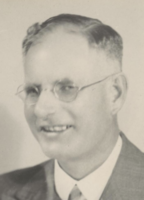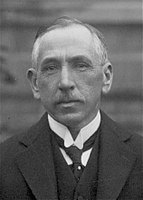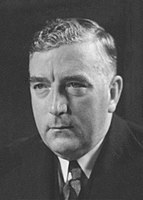1937 Australian federal election
| | |||||||||||||||||||||||||||||||||||||||||||||||||||||||||||||
| |||||||||||||||||||||||||||||||||||||||||||||||||||||||||||||
| |||||||||||||||||||||||||||||||||||||||||||||||||||||||||||||
| |||||||||||||||||||||||||||||||||||||||||||||||||||||||||||||
The 1937 Australian Federal election will be held in Australia on 1 March 1937. All 74 seats in the House of Representatives, and 19 of the 36 seats in the Senate were up for election. This election was called approximately 8 months early than when incumbent Prime Minister Joseph Lyons intended to call it as his death in January of 1937 resulted in political instability that was resolved only with the appointment of John Curtin as caretaker Prime Minister and the holding of this immediate election. It will be contested by the Australian Labor Party, the UAP/Country Party Coalition and the newly formed Liberal Party of Australia.
Background
On January 13, 1937, Joseph Lyons, 10th Prime Minister of the Commonwealth of Australia passed away. Australia, still reeling from the Great Depression had been looking to his United Australia Party for guidance. The following morning, Deputy Prime Minister and Commerce Minister, Sir Earle Page, Leader of the Country Party was hastily appointed interim PM until the UAP could elect a successor. From here, the lessons begin, the evening of January 14th, the UAP Chief Whip informed the Governor General that four candidates for Leader of the UAP had emerged, one of whom was not a sitting MP. These were Attorney General, The Hon. Robert Menzies MP, Treasurer, The Hon. Richard Casey MP, Health Minister, Rt Hon. Billy Hughes MP and finally, Dame Enid Lyons, candidate for the yet to be declared by-election in her husband's former seat. Enid Lyons would go on to succeed her husband in the early election of 1937 instead and was quickly discounted on the first ballot securing only one vote. More on her, later.
The following day, January 15th, Casey was disqualified after he acquired the least votes, setting up a match between Hughes and Menzies, the two largest states delegations would largely back their respective candidate and it became clear shortly before the ballot on the evening of January 15th that Menzies would secure the party's support albeit by a narrow margin. This is where the crisis begins, thirty minutes before the MPs filed into the party room, Senators Alexander McLachlan and Harry Foll announce they would cross the floor should Menzies become Prime Minister. McLachlan because he drew his support for the party from the moderate voters, and Foll because he had narrowly won in 1934 and blamed Menzies for his failure to become Senate President in 1935. McLachlan's announcement was followed quickly by the failed candidate Richard Casey and External Affairs Minister, WA Senator George Pearce. The three Ministers collectively held enough sway to ensure that a Menzies Government would last no more than a single day in the House of Representatives. In response, Tom Price, the Chief Whip of the UAP informed the Governor-General he would postpone the ballot for 18 hours to allow for a mediation between Menzies and the would-be defectors.
On that morning of January 16th, Price convinced McLachlan to stand down under the condition that his fellow South Australian would be awarded the opportunity to move from the Senate to the House of Representatives in the seat of Wakefield at the 1937 Election but while Price delivered this memorandum, Hughes whipped enough votes so that McLachlan's deal would be useless. In response, Menzies offered to stand down, and allow Hughes to form government under the condition that he retain his Ministry and have a stronger say in appointments and candidate pre-selection. Hughes accepted, until at 11.30AM, forty-five minutes before he was due to enter the party room and become re-elected as PM by his own colleagues, the widowed Enid Lyons phoned him and convinced him to back out of the agreement. Swayed by his loyalty to the moderate half of his party, Hughes informed Menzies as they entered the room that Menzies would retain his Ministry but not be given his special status. Consequently, Menzies was taken aback and moved for a postponement until after the state funeral of Joseph Lyons 'as matters remain undecided and it would be unjust to succeed a man whose shoes are too big to fill in a single three days'. Price acquiesced and visited Government House that evening to inform the Governor-General. Privately, Menzies continued to work the numbers hoping to secure enough votes to ensure he'd remain Prime Minister should he be able to win the party room.
On January 17th, Enid Lyons departed Canberra with the body of her husband for Sydney's St Mary's Cathedral where he'd lay in state until the funeral four days afterwards. With her departure, and inability to communicate via telephone, Menzies continued to diligently whip votes to ensure he could survive a motion of no confidence, by midday he phoned fellow Victorian Richard Casey who informed him that half the Victorian delegation would not support Menzies as Prime Minister and that he would 'eagerly follow them across the floor'. From here arises our constitutionally theoretic question, who leads Government if the ruling party is in a position to threaten bringing its own party down over disagreements on who leads? Better put, if Menzies is appointed Prime Minister then defeated in a Motion of No Confidence, who should the Governor General be appointing? Qualifications for Prime Minister are the same as any MP with just one extra requirement, 'the confidence of the House of Representatives'. If Menzies' own party controls the confidence of the House but enough of his party are willing to signal no confidence in his leadership on the floor of the House, what are the consequences? "A Constitutional Crisis". That is what the original architects of this grand plan informed the Governor General on that evening. An impatient and furious Alexander Hore-Ruthven informed them and in writing, Thomas Price that if by 8AM January 18th, the UAP had no leader who could command the confidence of the House of Representatives then he would appoint John Curtin who unlike his UAP colleagues, had made clear his belief that an early election should be called to avoid a high profile by-election in the former Prime Minister's seat.
The deadline was set and at 7AM, January 18th, the crisis was resolved when the Governor-General's ultimatum was met with the UAP's declaration of 'a schism so great that no leader has been declared at this time'. Menzies and Hughes both won the same number of votes, Casey and McLachlan convinced enough of their members to boycott the meeting, ensuring that no leader could be declared as an absolute majority of the party room had not granted their support for a new leader. His Excellency then intervened directly, dismissing Sir Earle Page at 7.45AM, and at 8.15AM, delivering a commission to John J. A. Curtin to become the 11th Prime Minister of Australia. So, this crisis was resolved, Curtin would deliver a muted and symbolically gentle eulogy for his predecessor four days later at St Mary's Church in which he evoked 'the greater Australian self'. On January 26th, Australia Day, 1937, John Curtin would end the crisis once and for all, 13 days on from the death of his predecessor, by calling an early election at Government House, Canberra. Polling day was set for March 1, 1937.



